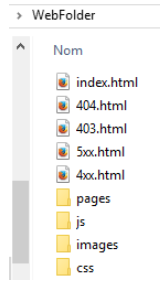Custom HTTP Error Pages
The 4D Web Server allows you to customize HTTP error pages sent to clients, based on the status code of the server response. Error pages refer to:
-
status codes starting with 4 (client errors), for example 404
-
status codes starting with 5 (server errors), for example 501.
For a full description of HTTP error status codes, you can refer to the List of HTTP status codes (Wikipedia).
Replacing default pages
To replace default 4D Web Server error pages with your own pages you just need to:
-
put custom HTML pages at the first level of the application's web folder,
-
name the custom pages "{statusCode}.html" (for example, "404.html").
You can define one error page per status code and/or a generic error page for a range of errors, named "{number}xx.html". For example, you can create "4xx.html" for generic client errors. The 4D Web Server will first look for a {statusCode}.html page then, if it does not exist, a generic page.
For example, when an HTTP response returns a status code 404:
-
4D Web Server tries to send a "404.html" page located in the application's web folder.
-
If it is not found, 4D Web Server tries to send a "4xx.html" page located in the application's web folder.
-
If not found, 4D Web Server then uses its default error page.
Example
If you define the following custom pages in your web folder:

-
the "403.html" or "404.html" pages will be served when 403 or 404 HTTP responses are returned respectively,
-
the "4xx.html" page will be served for any other 4xx error status (400, 401, etc.),
-
the "5xx.html" page will be served for any 5xx error status.